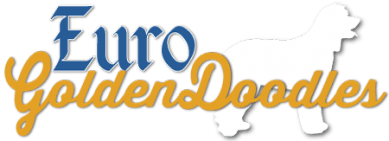-
info@eurogoldendoodles.com
-
704-990-8034
-
Mt. Holly, NC
Puppies and Chewing
Puppies are notorious chewers – hence the adage – and they’ll nosh on everything from handbags to furniture to theme papers about Tom Sawyer. It’s not that they’re intentionally trying to anger you (Though we know you’ll likely have to count to ten once you see your Italian briefcase dismembered.).
Pups, you see, are simply following Mother Nature’s instructions. They’re hard-wired to cut their teeth and they need something (or someone) to help them do it. Moreover, they use their mouths as a means to explore their environment, even to reduce tension. Many alleviate boredom this way. Others are just hungry for a snack. So, how do you cope with Mr. Motor Mouth’s habits?
Keep ‘Em Busy
You wouldn’t leave a 2-year-old child in a room alone for five hours, and the same rule should apply to puppies. Your furry whippersnapper needs to be stimulated physically and cognitively – often. This means:
- Offering a variety of safe chew toys or treats like puppy biscuits or pig’s ears. (Never give puppies chicken bones, as they can fracture and lead to significant damage or death.)
- Providing plenty of exercise, even if that means hiring a dog walker. (You might actually save money in the end when you realize you’ve preserved your baseball card collection.)
- Thinking up games that get him to use his noggin. (Try a round of “fetch” or hide a treat inside a hollow ball.)
- Attending to his needs quickly so that he doesn’t go on a boredom binge.
- Feeding him meals at regular intervals so that he doesn’t go looking for dinner.
Teach Your Pup to “Chew Smart”
If chewing is unavoidable, and it very likely will be during the time where your puppy is cutting their teeth, you might as well get him to eat the right stuff. Here’s how to do it:
- Praise your fur ball each and every time he chomps on something assigned to him. Reinforce this behaviour on occasion by offering him and edible treat.
- Do not confuse your puppy by first offering him an old slipper and then heckling him when he eats your mother-in-law’s loafers. Puppies are indeed smart, but they can’t read labels. Make sure he knows what’s his and what’s yours.
- Spray a commercial anti-chew solution, a bitter or hot tasting spray to goodies you’d like to safeguard. He’ll take one bite and avoid them later.
- If he goes after particular objects again and again simply remove them for a while. Reintroduce them at a later time.
- If an object of affection is too big to hide – a recliner, for instance – then try moving it to a different location in hopes that Pup will latch onto something else.
- Motion-activated alarms serve as a deterrent
- Try booby traps. Stack empty soft drink cans around the leg of the chair. The loud noise the cans make when tipped over might be enough to scare your puppy away forever.
Remember that the goal is not to scare your puppy from doing puppy things. The goal is to cleverly steer them in the right direction. You want them to trust you and the things you are asking them to do instead of being confused.
Exercise Smart Discipline- a.k.a “What Not To Do”
Pups caught in the act should be given a simple verbal reprimand followed by encouragement to chew on an appropriate toy. Practice this: “Chesapeake, no chew!” Then throw your canine a bone.
- Verbal reprimands alone can backfire by teaching the pet to be sneaky about chewing or by teaching him not to chew at all – even toys – in your presence.
- Never spank, slap, kick or otherwise physically punish a puppy. Not only is this nasty behavior on your part, but also it could result in your pet becoming hand shy or a fear-biter.

